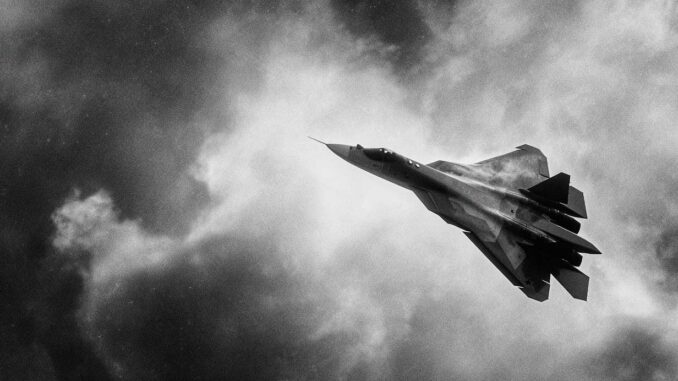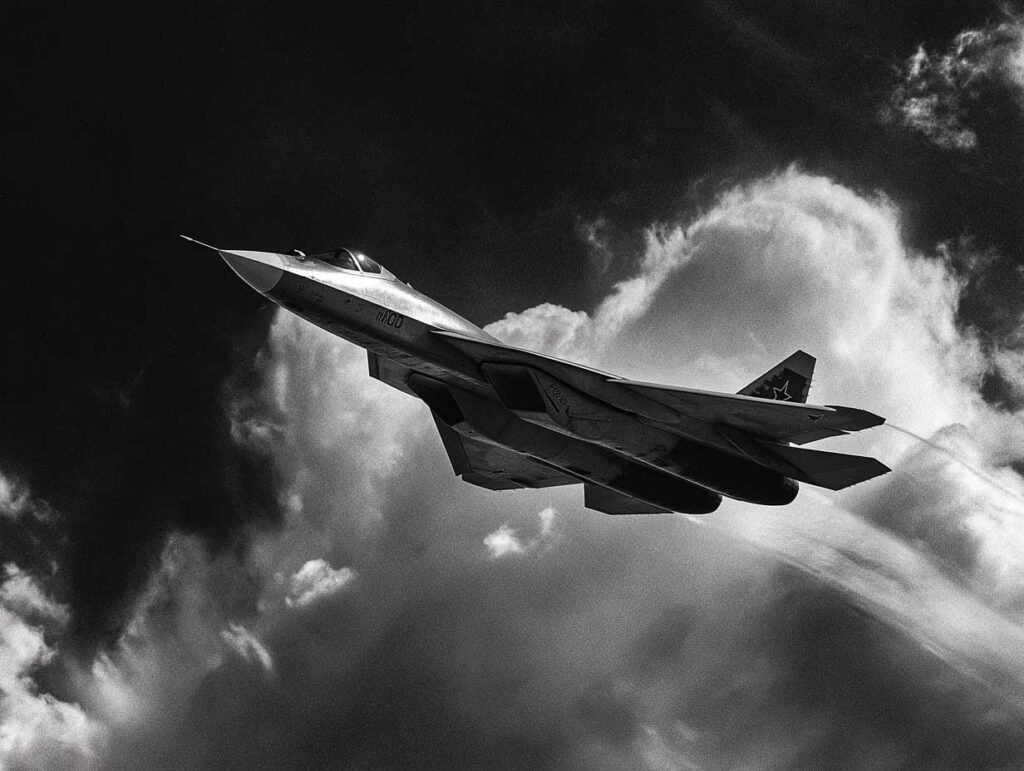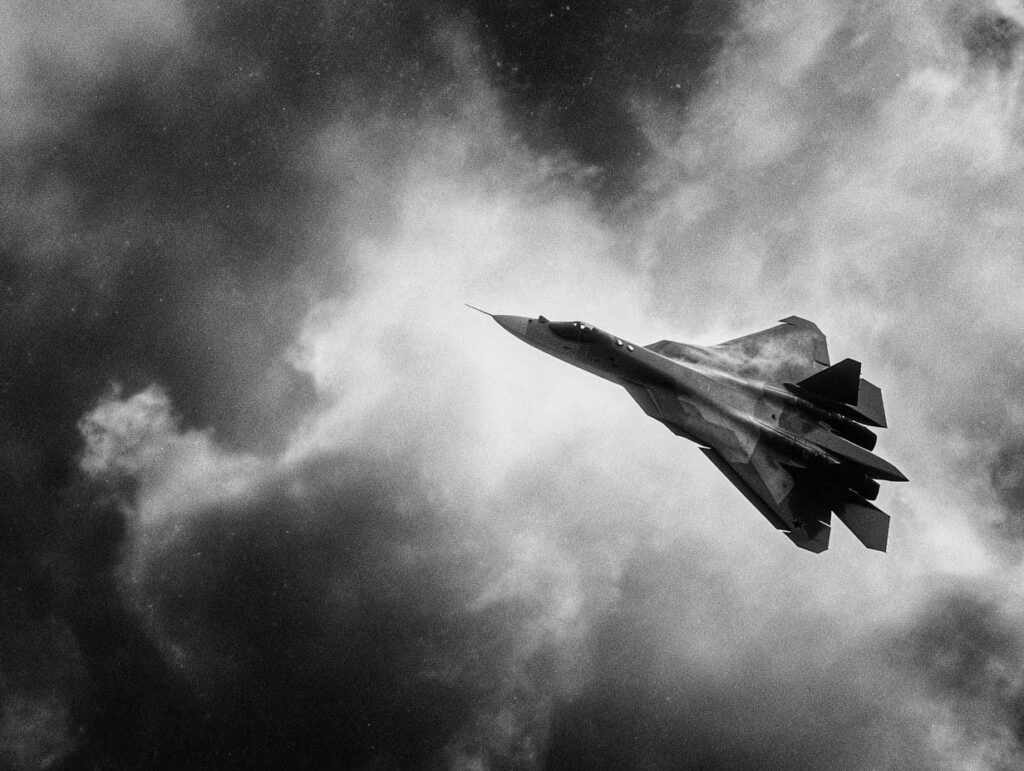
Discover 10 little-known technical facts about the SU-57, the Russian fighter jet developed by Sukhoi, including its stealth capabilities, drones, and extreme maneuvers.
The SU-57, developed by Sukhoi, embodies Russia’s bid for a fifth-generation stealth fighter jet capable of rivaling the F-22 and F-35. But beyond the official statements, this Russian fighter hides a series of technical features that are little known to the general public. From its armored cockpit to its compatibility with Okhotnik-B combat drones, not to mention its unique side bays and L-band secondary radars, every detail reveals a unique tactical approach. In this article, we explore 10 unusual and revealing facts that show how this Russian fighter jet reflects a unique military doctrine. Each point is explained in depth to give enthusiasts and professionals alike a better understanding of the SU-57’s design choices and operational limitations.
A two-seater prototype abandoned for budgetary reasons
Although the SU-57 program considered a two-seater version, this concept never made it past the inert prototype stage. In the 2010s, Sukhoi briefly explored the idea of a two-seat SU-57 for coordination missions with combat drones such as the S-70 Okhotnik-B, or to improve in-flight command capabilities in congested environments.
However, the cost of integrating a second cockpit, combined with the need to modify the aircraft’s structure, quickly caused the Russian authorities to back down. No operational two-seater model of the SU-57 has been observed during flight tests or public events.
This currently limits the SU-57’s appeal for remote human-machine collaborative control missions. In contrast, some programs, such as the US NGAD and the European SCAF, are considering a two-seat architecture from the outset. For the Russian Air Force, this means that a SU-57 fighter pilot will have to manage the flight, weapons and potentially drone control alone, which reduces the tactical margin in certain complex missions.

L-band radars integrated into the wings
The SU-57 differs from other stealth aircraft by integrating two L-band radars into its leading edges. These sensors work in conjunction with the main N036 Byelka radar, which operates in the X band. Unlike the X band, which is more accurate but easier to deceive with stealth shapes, the L band uses longer wavelengths that are better suited to detecting certain Western stealth fighter jets.
This solution is designed to detect aircraft such as the F-35, whose stealth has been optimized primarily against X-band radars. However, these L-band radars are less accurate for weapon guidance. They are therefore mainly used to detect suspicious presences in a large airspace, allowing the search to be refined with more accurate sensors.
By integrating these radars directly into the wing structure, Sukhoi has circumvented the problem of adding pods or external equipment, which would have compromised stealth. This demonstrates an interesting compromise between expanded detection and discreet integration, although their practical effectiveness remains poorly documented outside Russia.
Side bays specific to close combat
The SU-57 adopts a unique architecture for a stealth fighter: in addition to its central bay, it has two small side bays located between the air intakes and the fuselage.
These compartments are designed to carry short-range missiles such as the R-74M2, intended for close air combat. Their advantage lies in their speed of deployment: these bays allow missiles to be fired in a matter of seconds, without having to open the large hatches of the central bay. This capability is an advantage for a fighter pilot engaged in a dogfight, where rapid reaction is crucial.
However, this configuration imposes constraints: space is limited, so only compact missiles can be accommodated. In addition, these additional openings slightly increase the radar signature in flight when activated.
This choice illustrates Sukhoi‘s goal of integrating dogfighting capabilities into a stealth aircraft, whereas the F-22 and F-35 rely on distance and stealth to avoid close combat.
An infrared signature that is difficult to mask
The SU-57 remains equipped with AL-41F1 engines, derived from the AL-31 program of the 1990s. Although they have been improved, these engines produce a high thermal signature, particularly in afterburner mode.
This characteristic makes the aircraft more vulnerable to detection by infrared sensors such as the IRST21 carried by the F-15EX or the DAS of the F-35. During rapid climb or full-power maneuvers, the heat emitted can be detected from several dozen kilometers away, reducing the effect of radar stealth.
The future Izdeliye 30 engine, currently under development, promises to reduce this signature, but its operational integration has been postponed until after 2027. In the meantime, this limits the SU-57’s performance in deep penetration or long-range interception missions, especially against adversaries equipped with advanced IR sensors.
For a Russian fighter pilot, this vulnerability requires careful management of thrust and thermal exposure, particularly in areas under constant IR surveillance.
A partially armored cockpit
In keeping with Russian doctrine of ruggedness, the SU-57 is one of the few modern fighter jets to feature a partially armored cockpit. Titanium or ceramic plates protect certain critical areas around the seat and vital systems.
This lightweight armor, weighing approximately 50 to 70 kg, is designed to withstand small-caliber projectiles (12.7 mm) or nearby shrapnel. Obviously, it does not offer protection against missiles, but it does increase the fighter pilot’s chances of survival in the event of a ground attack, friendly fire, or a nearby explosion.
This choice contrasts with Western aircraft, which favor maximum weight reduction. For the Russian Air Force, this approach is consistent with the expected operations of the SU-57: deployment from unsecured bases, risk of exposure to ground fire, and an asymmetric war environment.
Three-dimensional thrust vectoring
The SU-57 is equipped with two-axis thrust nozzles, providing 3D thrust vectoring. This capability allows the direction of the engine flow to be changed not only vertically (pitch), but also laterally (yaw), providing exceptional maneuverability, especially at low speeds.
During air demonstrations, the SU-57 has shown its ability to perform tight turns, tight loops, and maneuvers such as the Cobra or fishtail, which are difficult for an aircraft without thrust vectoring.
This maneuverability can be a decisive advantage in close combat. However, these maneuvers generate a strong infrared signature and consume a lot of kinetic energy. In an environment where heat-seeking missiles dominate, this is a risky compromise.
Russian fighter jets have historically relied on this extreme agility to compensate for their partial stealth, but this requires highly skilled fighter pilots and the ability to anticipate enemy reactions.
Prototypes with reused Soviet equipment
The first SU-57 demonstrators, designated T-50, were built in 2010 using components available on Russian production lines, including some systems inherited from the Soviet era. This was particularly the case for flight instruments and certain avionics components, as the latest generation parts were not available at the time.
Military observers reported that the first test flights featured analog instruments in the cockpit, particularly for navigation and secondary flight controls. The full integration of multifunction digital displays was only finalized on the first production models delivered to the military after 2020.
This dependence on existing stocks slowed down the industrial standardization process for the program. It also illustrates the difficulty of technological modernization faced by the Russian aviation industry in the face of Western sanctions on electronic components since 2014. For a fifth-generation Russian fighter jet, this represented a significant design delay compared to US and European standards.
Compatibility announced with Okhotnik-B drones
The SU-57 was designed to operate in coordination with the S-70 Okhotnik-B heavy combat drone, also developed by Sukhoi. This 20-ton stealth drone, shaped like a flying wing, is intended to carry out long-range strikes, penetrating reconnaissance, or saturation missions in support of the SU-57.
In this configuration, the SU-57 acts as a command node, transmitting orders, targets, and flight parameters to the drones. This man-machine approach offers an obvious force multiplier: multiple drones can follow independent trajectories while remaining under human control.
However, this integration is still in the experimental phase. No combined operational mission flights have been documented to date. The lack of a two-seater version of the SU-57 also limits collaborative piloting capabilities, as a single fighter pilot will have to control the aircraft and manage the drones in an intense tactical environment.
Nevertheless, this capability reflects Russia’s intention to follow the global trend toward integrating manned and unmanned systems in modern fighter aircraft.

A central bay too short for the R-37M missile
The R-37M missile, the flagship of the Russian arsenal for very long-range interception, cannot be carried in the internal bay of the SU-57. This missile, which measures over 4.2 meters and weighs approximately 600 kg, exceeds the dimensional capacity of the stealth fighter’s internal compartments.
The R-37M is designed to strike AWACS aircraft or refuelers at ranges of over 300 kilometers, but it must be carried on an external pylon under the fuselage of the SU-57. This instantly compromises the aircraft’s stealth, as the external load significantly increases its radar cross-section.
This dilemma reveals an unresolved trade-off in the SU-57’s design: integrating high strike power without compromising electromagnetic stealth. To date, Sukhoi does not offer an equivalent stealth alternative for this mission. This limits the SU-57’s ability to engage certain types of targets while remaining undetectable.
Series production still limited in 2025
Despite official announcements, production of the SU-57 remains well below initial targets. In 2019, the Russian Ministry of Defense ordered 76 units to be delivered by 2028. However, in the summer of 2025, fewer than 20 fully operational aircraft were recorded in the Russian Air Force.
The delays are due to several factors: industrialization problems, supply disruptions caused by sanctions, difficulties in finalizing the engines, and priorities being redirected to the conflict in Ukraine.
This reduced production rate limits large-scale deployment capabilities. Russia does not yet have a critical mass of SU-57s to alter the tactical balance in a given area. In addition, according to several specialized sources, some of the aircraft delivered are still partially equipped, with unfinished electronic modules.
This lack of operational availability currently prevents the SU-57 from competing in terms of volume with Western fleets such as those of the F-35, which has already been deployed in more than 950 units in 17 countries.
War Wings Daily is an independant magazine.